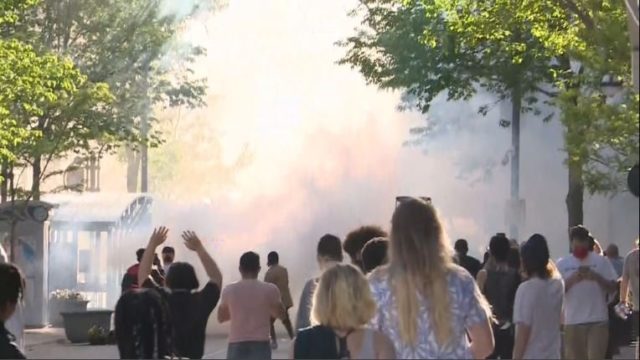From our content partner, Channel 3000
MADISON, Wis. — A third-party report into how the Madison Police Department handled protests during the summer of 2020 finds the department was not prepared for the scale of the demonstrations or anger they faced.
The third-party report was requested by former interim Chief Vic Wahl following protests over the death of George Floyd on May 30-June 1 and another set of protests later in the summer that saw statues pulled down outside the State Capitol and the attempted firebombing of several buildings downtown, including the City-County Building.
The report notes most of the individuals who took part in the protest remained peaceful, but the violence came from a small group of people.
Several people taking part in the violence were later identified through security cameras, prosecuted and charged through the rest of 2020 and 2021. The statues outside the State Capitol were restored earlier this year.
“While MPD has always sought to communicate effectively with the community, it was unprepared for the scope and emotion of the May 30 protests, in large part because of a lack of communication between MPD and community activists,” the report found. “In part this was a function of a larger gap between community and MPD, as many community organizers refuse to engage with MPD. Communication gaps continued throughout the summer of 2020 and persist today.”
“‘Unprepared,’ I would view as a statement of fact rather than a criticism,” Professor John Holloway of the Quattrone Center said Tuesday afternoon. “I think it would be very difficult and, we certainly saw in cities across the country, protests that escalated to violence for which the departments were not expecting.”
The report acknowledges MPD’s “Madison Method” of handling protests typically involves prioritizing the Constitutional right to assemble and maintaining an open dialogue with citizens before, during and after protests, while also balancing the rights of protesters with the rights of the community at large, “protecting people first and property second.”
However, that method proved ineffective due to the lack of communication before, during and after the protests.
The report recommended Madison police emphasize a “less is more” approach to future protest events, especially when police themselves are the focus of the protest.
“When the police are the subject of the protest, a demonstration of police force can become escalatory rather than calming,” Holloway said. “So having the community be communicating with MPD in constructive ways and allow the protest to continue is a way of showing support to the community that helps keep things calm.”
As part of the report, the Quattrone Center talked to more than 50 officers about their experiences on those nights, including some of the things that were said to them by members of the community.
“We are the most visible form of government. And we’re that form of government that has the ability to take away your freedom and in some cases, to take away your life. And people were frustrated by that,” Barnes said.
The report also concluded MPD should refocus their de-escalation techniques during protests to focus on “proportional reactions” to stop instigators of violence.
That includes saying MPD should avoid using gas or other methods of dispersing groups whenever possible, only using them when officers are unable to safely de-escalate a situation through targeted interventions or arrest, or when the use of gas or pepper spray is necessary to prevent imminent injury to other people.
The findings did find that historically, MPD has honored and respected the community’s first amendment rights to assembly and protest through the “Madison Method,” and said the willingness and cooperation of high-ranking MPD officials throughout the review shows their commitment to reform.
MPD invited a “highly diverse group of community and law enforcement stakeholders” to help conduct the report, identify contributing factors and come up with specific recommendations for reform.
In all, the report identified 133 contributing factors to the violence and property damage stemming from the otherwise peaceful protests, and makes 69 reform recommendations. One of those recommendations was requiring officers responding to incidents with large crowds to wear body cameras, something Police Chief Shon Barnes says he favors.
“I believe in body-worn cameras. I think it goes a long way to establish trust and transparency with our public and I will certainly be working to ensure that our department explores body-worn cameras,” Barnes said.
The issue of body cameras has come up many times in recent years in the City of Madison, with the Common Council historically reluctant to approve them. Barnes says he’d like to see the process move forward, but the department needs Council approval to begin a pilot program.
Madison Mayor Satya Rhodes-Conway welcomed the findings of the report, and praised the Madison Police Department for being the only department in the country to request the review.
“I have had a chance to review the executive summary and a constant theme is communication, communication before, during and after protest events. It’s apparent that clearer communication would build trust and help ensure public safety,” the mayor said in a statement Tuesday.
Barnes agreed that fixing communication is one of the recommendations that can be implemented immediately.
“The recommendation of having community dialogue representatives is something that our department explored last year and we’re further exploring that, but that’s a partnership between the police department and those community members who want to make sure everyone’s safe,” Barnes said.
The mayor says she also welcomes feedback based on the report.
“I hope that our residents, boards and committees will take a look at the report and tell us what they think. Chief Barnes and I both believe in continuous improvement, and with dozens of recommendations, I am sure there is much to learn from this report,” she added.
A full copy of the report is available here.




























